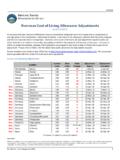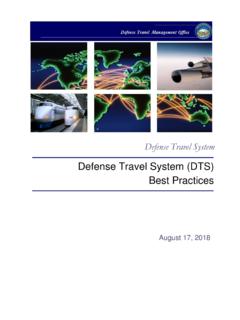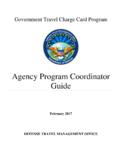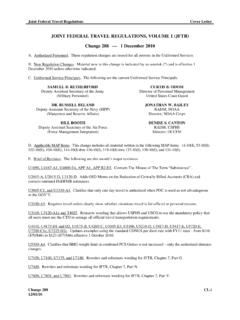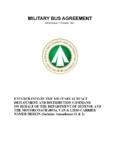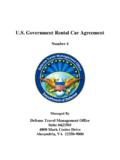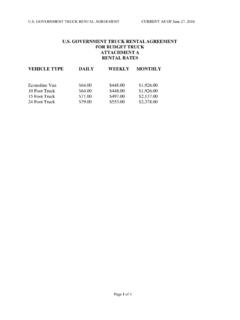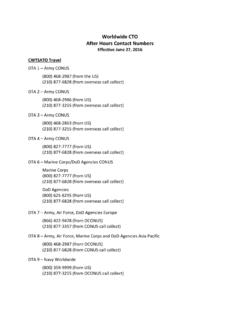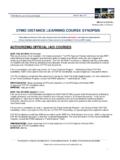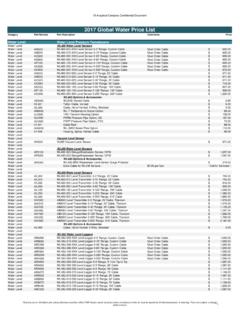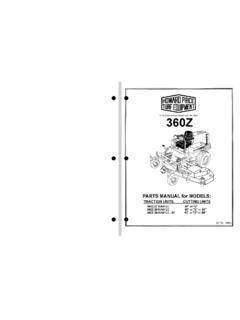Transcription of OVERSEAS COST-OF-LIVING RETAIL PRICE …
1 RETAIL PRICE Schedule Handbook OVERSEAS COST-OF-LIVING RETAIL PRICE SCHEDULE HANDBOOK. General Information This Handbook contains instructions for completing the 2016 Excel version of the OVERSEAS RETAIL PRICE Schedule, or COLA report. The item specifications apply to completion of Local, Embassy Commissary, and Military Commissary and Exchange reports. Submission of Reports The Defense Travel Management Office (DTMO) Allowances Branch uses information from the Living Pattern Survey, and the RETAIL PRICE Schedule, to develop Department of Defense COST-OF-LIVING Allowances for members of the Uniformed Services assigned outside the Contiguous United States. The preparation and submission of surveys and reports for military members is explained in Appendix M of the Joint Travel Regulations (JTR). The RETAIL PRICE Schedule is available from the Defense Travel Management Office Web Site at: If you have COLA survey preparation questions please contact: Defense Travel Management Office Strategic Planning and Policy Division, Allowances Branch 4800 Mark Center Drive, Suite 04J25-01.
2 Alexandria, VA 22350-9000. E-mail: Commercial: 571-372-1300. DSN: 372-1300. 1. July 2016. RETAIL PRICE Schedule Handbook TABLE OF CONTENTS. Page Number Introduction: General Information on Submission of Reports 1. Table of Contents 2-3. PART 1. RETAIL PRICE SCHEDULE PREPARATION GUIDELINES. a. Living Pattern Survey 4. b. Annual Reporting Dates 4. c. Responsible Officer 4. d. Coordination 4. e. Basic Techniques of PRICE Collection 5. f. Selection of Local RETAIL Outlets 5. g. Commissary and Exchange Prices 5. h. Selection of Items and Prices 5. i. Review before Submission 6. PART 2. ITEM SPECIFICATIONS. General Information 8. Meat and Dairy Products (Part A) 9. Groceries (Part B) 10. Fruit and Vegetables (Part C) 11. Alcohol and Tobacco (Part D) 12. Clothing (Part E) 13. Personal Care (Part F) 13. 2. July 2016. RETAIL PRICE Schedule Handbook TABLE OF CONTENTS. Page Number Furnishings/Household Appliances and Supplies (Part G) 15. Medicine (Part H) 16.
3 Recreation (Part I) 17. Public Transportation (Part J) 19. Personally owned Vehicle (Part K) 19. Child Care and Household Help (Part L) 21. 3. July 2016. RETAIL PRICE Schedule Handbook Part 1. RETAIL PRICE Schedule Preparation Guidelines a. Living Pattern Survey A Living Pattern Survey (LPS) must be completed before a RETAIL PRICE Schedule (RPS). can be initiated. In the LPS, military members report the names and addresses of the local RETAIL outlets most commonly used to purchase goods and services at OVERSEAS locations. The PRICE collector(s) uses these outlets to record prices for the RPS. JTR Appendix M describes the preparation and submission of the LPS and RPS. A. new LPS must be conducted every three years, or whenever there is a substantial change in living patterns at the duty station. b. Annual Reporting Dates for the RETAIL PRICE Schedule JTR Appendix M lists the OVERSEAS locations required to submit an annual RPS and the month that reports are due.
4 If an OVERSEAS location is considering a voluntary submission of an unscheduled RPS, the officer responsible for the RPS should contact DTMO, Allowances Branch before PRICE collection is started. c. Responsible Officer JTR Appendix M describes procedures for appointing OVERSEAS Country Allowance Coordinators, also known as Points of Contact, who have overall responsibility for preparation of the RPS. Neither the responsibility for the report, nor the PRICE collection, should be delegated to a local national. Because this report must accurately reflect foreign living costs for the average American military family, the officer responsible must be familiar with the RETAIL outlets and types of goods and services generally used. For the RPS, the average family consists of an E-6 or O-3 with three dependents. d. Coordination The welfare of all Uniformed members at an OVERSEAS location depends on the accuracy of the RPS. For this reason, the officer responsible should contact the heads of all local military agencies and invite them to participate in the RPS reporting process.
5 When the RPS is finished, the responsible officer should review it for completeness and accuracy, and must then obtain the signed concurrence of representatives of all Government Military Commands affected by the report. Signatures of the responsible officer and representatives of Commands affected by the report should be submitted to DTMO, Allowances Branch on page 1 of the RPS. 4. July 2016. RETAIL PRICE Schedule Handbook e. Basic Techniques of PRICE Collection The officer responsible for the report may either collect RETAIL PRICE information alone, or may identify one or more members to collect the data. PRICE collectors must personally visit the RETAIL outlets, inspect items, and record prices. When possible, they should also meet with the store or department manager to explain the reasons for the report and its importance to the American community. If PRICE collectors are asked to pledge confidentiality, or to place other restrictions on the use of data they collect from a specific RETAIL establishment, the responsible officer must note this in an attachment to the report.
6 This specific proprietary information will then not be subject to disclosure under the Freedom of Information Act. The ability of the program to obtain objective and reliable PRICE data depends on the goodwill and cooperation of the local RETAIL merchants. The specific types of goods and services that the RPS requires from each source are detailed in Part 2, Item Specifications. PRICE collectors should follow these specifications, pricing as close to American quality as local conditions permit. f. Selection of Local RETAIL Outlets The most recent LPS contains the names of two local RETAIL establishments most frequently used for purchasing various categories of goods and services ( meat, groceries, clothing, etc.). PRICE collectors must visit these RETAIL establishments to collect information on the corresponding goods and services. If an establishment no longer carries a particular product, a substitute outlet, which is also popular among the members, should be chosen and the information collected.
7 Use the comments section of the appropriate pages to explain why the substitution was necessary. g. Commissary and Exchange PRICE Collection If the reporting locality has a base exchange or commissary, a second report with a full set of prices, in dollars, must also be completed. Using the Commissary/Exchange RPS, record the prices of goods and services available at the commissary and the exchange. Follow the same item specifications in Part 2, listed for local RETAIL outlets. h. Selection of Items and Prices The RPS lists specific consumer goods and services and contains spaces for the PRICE collectors to record the quantity, unit, PRICE , and a brief description. PRICE collectors should select items that an average American military family would typically buy. For purposes of this report, the average family consists of an E-6 or O-3 with 3 dependents. The typical item is that which the average family would purchase; the substitute item may be less expensive, but is still of a quality and PRICE acceptable to the typical member.
8 5. July 2016. RETAIL PRICE Schedule Handbook Items: If there has been a previous RPS, it must be used as a guide in preparing the new report. Report the prices of the same type, brand, or model of individual items from year to year when possible. Avoid item substitutions except when an item is not available locally. If a substitution is made, there must be an explanation in the comments section. The items selected should be as close as possible in quality to those found in the Size: If the requested size is not available, the closest equivalent size should be selected, and the substitution should be explained in the comments section. The PRICE collector must record the local weights and measures ( kilograms, liters) for each item; size must not be converted into pounds and ounces. Bulk or very large sized items should not be selected unless the typical American family would buy them. PRICE levels: Reporting both the typical and the substitute PRICE levels is important.
9 If an item is temporarily out of stock, the most recent PRICE should be listed in the report. Anticipated PRICE changes should be listed separately. Every effort should be made to provide both prices requested for both of the outlets. If the first or second most frequently used outlets do not carry the item requested, the PRICE collector should visit another RETAIL outlet (preferably the third most used outlet as determined by the LPS) to collect the PRICE data. Sale items: All prices in the report should be those actually paid by Americans. If a required item is on sale, the regular PRICE , the special sale PRICE , and the duration of the sale must be reported. Discounts: If prices are significantly lower when purchased with dollars or other forms of currency, this should be reported. Special cash discounts and delivery charges should be reported in the description or comments sections. The local RETAIL prices reported must be available to all American residents.
10 Taxes: The report requires the tax rate for each category of goods and services. If the reported prices do not include local RETAIL sales taxes, the amount of tax added to each item by the merchant (at the time of purchase) should be clearly reported at the top of each page and NOT added to the PRICE of the item. If taxes are included in the reported PRICE , indicate that yes, tax is included on the report. Currency: Report prices in the currency charged by the individual outlet. Explain all usage of non-local currency. The PRICE collector should not convert local currency prices into dollars. i. Review before Submission Omissions: The responsible officer should carefully review the completed report to make certain that it contains all of the requested information. Although every item on the report might not be used by all of the members at the OVERSEAS location, each item represents a broad class of other goods and services purchased by the average 6.
